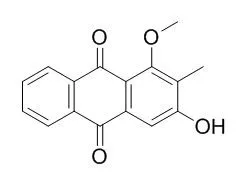| Description: |
Rubiadin-1-methyl ether probed as Type I photosensitizers. Rubiadin 1-methyl ether decreases the number of parasites (schizonts) in a dose-dependent manner, and 100% of inhibition was obtained with 30 to 40 micrograms. Rubiadin-1-methyl ether shows strong enhancing activity for adipocyte differentiation, it could be beneficial in the treatment of diabetes. Rubiadin-1-methyl ether has therapeutic potential against osteoporosis, it can promote osteoblast proliferation and inhibit osteoclast TRAP activity and bone resorption, and the inhibitory effects on osteoclastic bone, antiosteoporotic activity of M. officinalis .
|
| In vitro: |
| Nat Prod Res. 2012;26(18):1750-4. | | Anthraquinones from Morinda officinalis roots enhance adipocyte differentiation in 3T3-L1 cells.[Pubmed: 22008000] | To search for anti-diabetic and insulin-sensitising natural products, the effect on adipocyte differentiation was investigated by assessing fat accumulation in 3T3-L1 preadipocytes using Oil Red O staining.
METHODS AND RESULTS:
Fractionation and separation of n-hexane and CHCl₃ fractions of Morinda officinalis (Rubiaceae) using several chromatographic methods led to the isolation of three anthraquinones, 1,2-dimethoxyanthraquinone (1), alizarin-2-methyl ether (2) and rubiadin-1-methyl ether (3). Among them, alizarin-2-methyl ether (2) showed the strongest enhancing activity, followed by Rubiadin 1-methyl ether (3) and 1,2-dimethoxyanthraquinone (1). At a concentration of 100 µM, alizarin-2-methyl ether (2) enhanced adipocyte differentiation by up to 131% (compared to insulin-treated cells).
CONCLUSIONS:
Thus, these compounds could be beneficial in the treatment of diabetes. | | Planta Med. 1992 Dec;58(6):533-4. | | Effects of three compounds extracted from Morinda lucida on Plasmodium falciparum.[Pubmed: 1484892] | The effects of three compounds, digitolutein (1), Rubiadin 1-methyl ether (2) and damnacanthal (3) extracted from the stem bark and the roots of Morinda lucida Benth. on the growth of Plasmodium falciparum in vitro were investigated.
METHODS AND RESULTS:
The number of parasites (schizonts) decreased significantly in a dose-dependent manner, and 100% of inhibition was obtained with 30 to 40 micrograms of each compound tested. The IC50 values were calculated. | | J Photochem Photobiol B. 2005 Jan 14;78(1):77-83. | | Natural anthraquinones probed as Type I and Type II photosensitizers: singlet oxygen and superoxide anion production.[Pubmed: 15629252 ] | The photosensitizing properties of six anthraquinones (AQs): soranjidiol (1), soranjidiol-1-methyl ether (2), rubiadin (3), rubiadin-1-methyl ether (4), damnacanthal (5) and damnacanthol (6), isolated from leaves and stems of Heterophyllaea pustulata Hook. f. (Rubiaceae) were studied.
METHODS AND RESULTS:
By means of photobiological and photophysical methods in vitro, the type of photosensitization that these metabolites are capable of producing was determined. Whereas the photosensitized generation of superoxide anion radical (O(2)(-)) (Type I) was evaluated in leukocyte suspensions, singlet molecular oxygen ((1)O(2)) production (Type II) was examined in organic solution. In addition, the quantum yield of (1)O(2) (Phi) in chloroform was measured for those AQs that generate it.
CONCLUSIONS:
It was established that 4 behaves exclusively as a Type I photosensitizer. By contrast, the others AQs act by both types of mechanisms, among which 5 showed the largest Phi of (1)O(2). | | Biochem Biophys Res Commun . 2018 Dec 2;506(4):927-931. | | Rubiadin-1-methyl ether from Morinda officinalis How. Inhibits osteoclastogenesis through blocking RANKL-induced NF-κB pathway[Pubmed: 30392907] | | Abstract
Rubiadin-1-methyl ether (RBM) is a natural anthraquinone compound isolated from the root of Morinda officinalis How. In our previous study, RBM was found to have inhibitory effects on the TRAP activity of osteoclasts, which means that RBM may be a candidate for therapy of bone diseases characterized by enhanced bone resorption. However, the further effect of RBM on osteoclasts and the underlying mechanism remain unclear. In the present study, we investigated the effects of RBM isolated from Morinda officinalis How. on osteoclasts derived from bone marrow macrophages (BMMs) and the underlying mechanism in vitro. RBM at the dose that did not affect the viability of cells significantly inhibited RANKL-induced osteoclastogenesis and actin ring formation of osteoclast, while RBM performed a stronger effect at the early stage. In addition, RBM downregulated the expression of osteoclast-related proteins, including nuclear factor of activated T cells cytoplasmic 1 (NFATc1), cellular oncogene Fos (c-Fos), matrix metallopeptidase 9 (MMP-9) and cathepsin K (CtsK) as shown by Western blot. Furthermore, RBM inhibited the phosphorylation of NF-κB p65 and the degradation of IκBα as well as decreased the nuclear translocation of p65. Collectively, the results suggest that RBM inhibit osteoclastic bone resorption through blocking NF-κB pathway and may be a promising agent for the prevention and treatment of bone diseases characterized by excessive bone resorption. |
|






 Cell. 2018 Jan 11;172(1-2):249-261.e12. doi: 10.1016/j.cell.2017.12.019.IF=36.216(2019)
Cell. 2018 Jan 11;172(1-2):249-261.e12. doi: 10.1016/j.cell.2017.12.019.IF=36.216(2019) Cell Metab. 2020 Mar 3;31(3):534-548.e5. doi: 10.1016/j.cmet.2020.01.002.IF=22.415(2019)
Cell Metab. 2020 Mar 3;31(3):534-548.e5. doi: 10.1016/j.cmet.2020.01.002.IF=22.415(2019) Mol Cell. 2017 Nov 16;68(4):673-685.e6. doi: 10.1016/j.molcel.2017.10.022.IF=14.548(2019)
Mol Cell. 2017 Nov 16;68(4):673-685.e6. doi: 10.1016/j.molcel.2017.10.022.IF=14.548(2019)